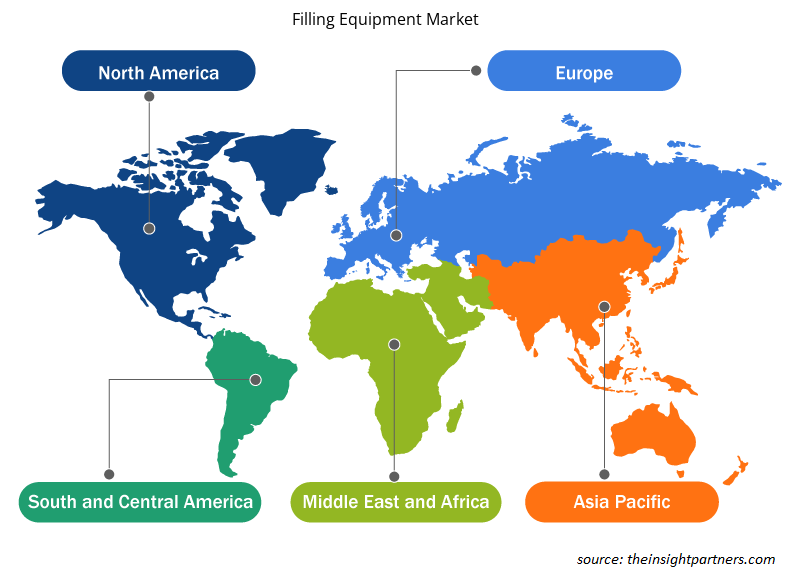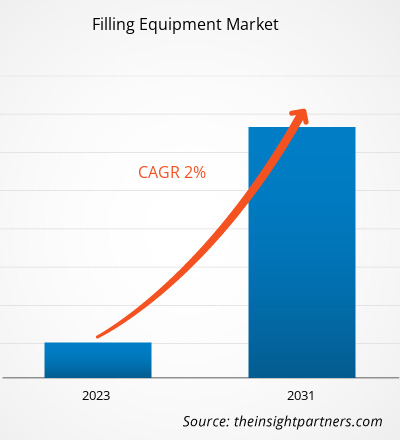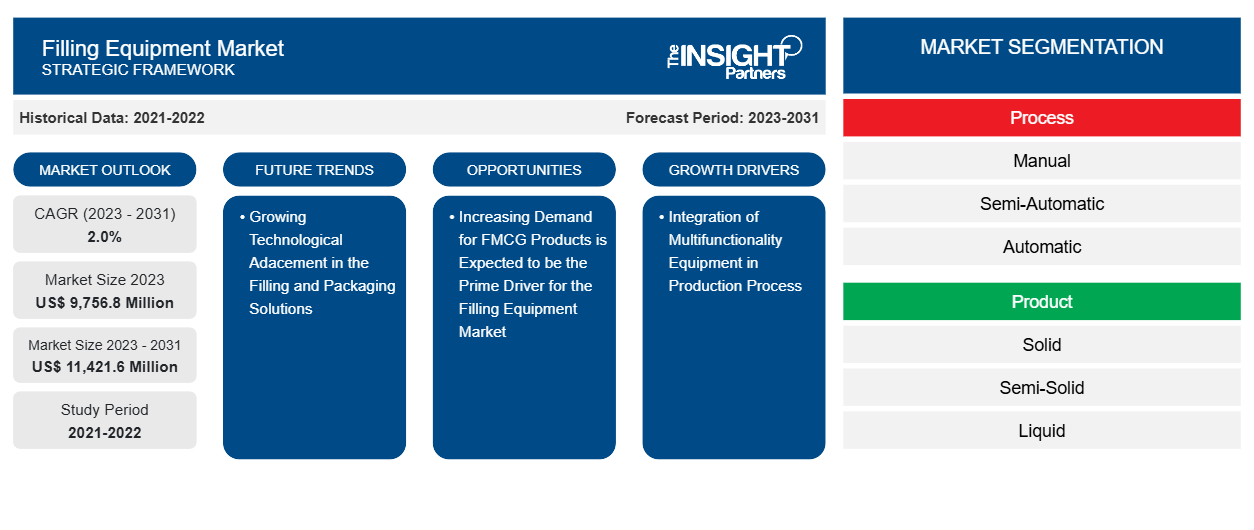Der Markt für Abfüllanlagen soll von 9.756,8 Millionen US-Dollar im Jahr 2023 auf 11.421,6 Millionen US-Dollar im Jahr 2031 anwachsen. Der Markt soll in den Jahren 2023–2031 eine durchschnittliche jährliche Wachstumsrate (CAGR) von 2,0 % verzeichnen. Eine erhebliche industrielle Entwicklung, eine steigende Kaufkraftparität der Verbraucher und die zunehmende Einführung automatisierter Technologien sind die Faktoren, die das Wachstum des Marktes für Abfüllanlagen im Prognosezeitraum voraussichtlich vorantreiben werden.CAGR of 2.0% in 2023–2031. Substantial industrial development, rising consumer purchasing power parity, and growing adoption of automated technology are the factors that are expected to propel filling equipment market growth over the forecast period.
Abfüllanlagen Marktanalyse
Die erforderlichen Produktionsergebnisse, fortschrittliche technologische Unterstützung, ein Minimum an menschlichem Eingriff und die Integration von Automatisierung und Robotik sind einige der Schlüsselfaktoren, die Hersteller dazu bewegen, sich für Abfüllanlagen zu entscheiden. Strenge staatliche Vorschriften für die Getränke- , Lebensmittel- und verwandten Branchen zwingen Hersteller von Abfüllmaschinen dazu, sich für Standardisierung zu entscheiden, um die Qualität des Produkts und die erforderliche Hygiene sicherzustellen. Darüber hinaus wird erwartet, dass die zunehmende Konzentration der Verbraucher auf bequem verarbeitete und verpackte Produkte, Bevölkerungswachstum, steigende Einkommen, zunehmende Urbanisierung und Gesundheitsbewusstsein die Nachfrage nach Abfüllanlagen im Prognosezeitraum ankurbeln werden.
Marktübersicht für Abfüllanlagen
Abfüllanlagen sind Maschinen, die zum Abfüllen von festen, halbfesten, pulverförmigen und flüssigen Produkten in Behälter wie Kartons, Beutel, Flaschen oder Tüten verwendet werden. Der Markt ist nach Verfahren, Produkt, Endverbraucher und Geografie unterteilt. Basierend auf dem Verfahren ist der Markt in manuelle, halbautomatische und automatische Produkte unterteilt. Basierend auf dem Produkt ist der Markt in feste, halbfeste, flüssige und pulverförmige Produkte unterteilt. Es wird erwartet, dass das flüssige Segment im Prognosezeitraum das am schnellsten wachsende Segment sein wird. Auf der Grundlage des Endverbrauchers ist der Markt in Pharmazeutika, Lebensmittel und Getränke, Kosmetik und andere segmentiert. Die steigende Nachfrage nach Abfüllanlagen in der FMCG-Industrie ist einer der wichtigsten Antriebsfaktoren für den Markt. Hohe Installations- und Wartungskosten können jedoch das Wachstum des Marktes in einigen Anwendungen behindern.
Passen Sie diesen Bericht Ihren Anforderungen an
Sie erhalten kostenlos individuelle Anpassungen an jedem Bericht, einschließlich Teilen dieses Berichts oder einer Analyse auf Länderebene, eines Excel-Datenpakets sowie tolle Angebote und Rabatte für Start-ups und Universitäten.
-
Holen Sie sich die wichtigsten Markttrends aus diesem Bericht.Dieses KOSTENLOSE Beispiel umfasst eine Datenanalyse von Markttrends bis hin zu Schätzungen und Prognosen.
Treiber und Chancen auf dem Abfüllanlagenmarkt
Die steigende Nachfrage nach FMCG-Produkten dürfte der Haupttreiber für den Markt für Abfüllanlagen seinFMCG Products is Expected to be the Prime Driver for the Filling Equipment Market
Die Entwicklung der Branche für schnelldrehende Konsumgüter (FMCG) in Industrie- und Entwicklungsländern aufgrund der wachsenden Zahl neuer Akteure wird voraussichtlich die Nachfrage nach Abfüllanlagen weltweit ankurbeln. Die wachsende Zahl von FMCG-Produktherstellern weltweit führt zu einer großen Nachfrage nach Abfüll- und Verpackungstechnologien, was wiederum die Anwendung des Abfüllanlagenmarktes fördert. Abfüllung und Verpackung sind zu einem wichtigen Teil der Produktmarke geworden. Hersteller investieren stark in standardmäßige Abfüll- und Verpackungstechnologien, um die Hygiene aufrechtzuerhalten und mit den staatlichen Richtlinien Schritt zu halten. Die Verpackung eines Produkts spielt eine entscheidende Rolle, da sie in erster Linie die Aufmerksamkeit des Verbrauchers auf ein Produkt lenkt. Daher sind die zunehmende Verbreitung von Produktmarken und -marketing sowie der Fokus auf Prozessautomatisierung zur Effizienzsteigerung der Betriebszeit wichtige Antriebsfaktoren für den Abfüllanlagenmarkt.FMCG) industry in developed and developing nations, owing to the growing number of new players, is anticipated to propel the demand for filling the equipment market globally. The growing number of FMCG product manufacturers worldwide creates extensive demand for filling and packaging technologies, which, in turn, boosts the application of the filling equipment market. Filling and packaging have become a major part of the product branding. Manufacturers are investing highly in standard filling and packaging technologies to maintain hygiene to keep pace with government guidelines. The packaging of a product demonstrates a crucial role as it primarily draws consumer attention towards any product. Thus, the growing proliferation of product branding and marketing, along with the focus on process automation for operational time efficiency, are acting as major driving factors for the filling equipment market.
Wachsender technologischer Fortschritt bei Abfüll- und Verpackungslösungen
Der zunehmende Fokus auf Prozessautomatisierung und der steigende technologische Fortschritt bei Verpackungs- und Abfülllösungen dürften große Chancen für Abfüllanlagen in verschiedenen Branchen wie Lebensmittel und Getränke, Pharmazeutik, Konsumgüter und Chemie bieten. Die zunehmende Einführung von IoT, künstlicher Intelligenz und Datenüberwachungssystemen durch Produkthersteller zur Verbesserung der Betriebseffizienz und der Produktionszeit dürfte das Wachstum des Abfüllanlagenmarktes im Prognosezeitraum ebenfalls vorantreiben.FMCG, and Chemicals, among others. Increasing adoption of IoT, artificial intelligence, and data monitoring systems by product manufacturers to enhance operational efficiency and production time is also estimated to drive the filling equipment market growth over the forecast period.
Segmentierungsanalyse des Marktberichts für Abfüllanlagen
Wichtige Segmente, die zur Ableitung der Marktanalyse für Abfüllgeräte beigetragen haben, sind Prozess, Produkte und Endbenutzer.
- Basierend auf dem Verfahren wurde der Markt in manuell, halbautomatisch und automatisch unterteilt. Das halbautomatische Segment hatte im Jahr 2023 einen größeren Marktanteil.
- Basierend auf den Produkten wurde der Markt in fest, halbfest, flüssig und Pulver unterteilt. Das flüssige Segment hatte im Jahr 2023 einen größeren Marktanteil.
- In Bezug auf den Endverbraucher wurde der Markt in Lebensmittel und Getränke, Pharmazeutika, Kosmetik und andere segmentiert. Das Segment Lebensmittel und Getränke dominierte den Markt im Jahr 2023.
Marktanteilsanalyse für Abfüllanlagen nach Geografie
Der geografische Umfang des Marktberichts für Abfüllgeräte ist hauptsächlich in fünf Regionen unterteilt: Nordamerika, Europa, Asien-Pazifik, Naher Osten und Afrika sowie Südamerika.
Der asiatisch-pazifische Raum dominierte den Markt für Abfüllanlagen im Jahr 2023. Der asiatisch-pazifische Raum umfasst China, Australien, Indien, Japan und Südkorea. Die hohe Entwicklung und die zunehmende Verbreitung fortschrittlicher Technologien, wie halbautomatische oder automatisierte Abfüllanlagen in Zentren für die Herstellung von Lebensmitteln und Getränken, Konsumgütern und Chemikalien, werden voraussichtlich das Wachstum des Marktes im Prognosezeitraum vorantreiben. Die hohe Präsenz von Herstellern von Abfüllanlagen trägt ebenfalls zum Wachstum des Marktes für Abfüllanlagen im asiatisch-pazifischen Raum bei. Steigende Haushaltseinkommen und eine zunehmende Vorliebe für Kosmetika und verarbeitete Lebensmittel unterstützen die Entwicklung der Lebensmittel- und Getränke-, Pharma- und Konsumgüterindustrie im asiatisch-pazifischen Raum, was sich wiederum positiv auf den Markt in der Region auswirkt. Da die Abfüllanlagen eine entscheidende Rolle im Herstellungsprozess der Produkte spielen, konzentrieren sich die Hersteller stark darauf, hochwertige Abfüllanlagen zu integrieren, um Hygiene und Betriebseffizienz aufrechtzuerhalten. Daher wird erwartet, dass der zunehmende Fokus auf die Entwicklung neuer Produkte und den technologischen Fortschritt das Wachstum des Marktes im asiatisch-pazifischen Raum vorantreiben wird.
Regionale Einblicke in den Markt für Abfüllanlagen
Die regionalen Trends und Faktoren, die den Markt für Abfüllanlagen im Prognosezeitraum beeinflussen, wurden von den Analysten von Insight Partners ausführlich erläutert. In diesem Abschnitt werden auch die Marktsegmente und die Geografie von Abfüllanlagen in Nordamerika, Europa, im asiatisch-pazifischen Raum, im Nahen Osten und Afrika sowie in Süd- und Mittelamerika erörtert.

- Erhalten Sie regionale Daten zum Markt für Abfüllanlagen
Umfang des Marktberichts über Abfüllanlagen
| Berichtsattribut | Details |
|---|---|
| Marktgröße im Jahr 2023 | 9.756,8 Millionen US-Dollar |
| Marktgröße bis 2031 | 11.421,6 Millionen US-Dollar |
| Globale CAGR (2023 - 2031) | 2,0 % |
| Historische Daten | 2021-2022 |
| Prognosezeitraum | 2023–2031 |
| Abgedeckte Segmente |
Nach Prozess
|
| Abgedeckte Regionen und Länder |
Nordamerika
|
| Marktführer und wichtige Unternehmensprofile |
|
Marktteilnehmerdichte: Der Einfluss auf die Geschäftsdynamik
Der Markt für Abfüllanlagen wächst rasant, angetrieben durch die steigende Nachfrage der Endverbraucher aufgrund von Faktoren wie sich entwickelnden Verbraucherpräferenzen, technologischen Fortschritten und einem größeren Bewusstsein für die Vorteile des Produkts. Mit steigender Nachfrage erweitern Unternehmen ihr Angebot, entwickeln Innovationen, um die Bedürfnisse der Verbraucher zu erfüllen, und nutzen neue Trends, was das Marktwachstum weiter ankurbelt.
Die Marktteilnehmerdichte bezieht sich auf die Verteilung von Firmen oder Unternehmen, die in einem bestimmten Markt oder einer bestimmten Branche tätig sind. Sie gibt an, wie viele Wettbewerber (Marktteilnehmer) in einem bestimmten Marktraum im Verhältnis zu seiner Größe oder seinem gesamten Marktwert präsent sind.
Die wichtigsten auf dem Markt für Abfüllanlagen tätigen Unternehmen sind:
- Accutek Packaging Equipment Company, Inc.
- COESIA SpA
- GEA Group AG
- JBT Corporation
- KHS GmbH
Haftungsausschluss : Die oben aufgeführten Unternehmen sind nicht in einer bestimmten Reihenfolge aufgeführt.

- Überblick über die wichtigsten Akteure auf dem Markt für Abfüllanlagen
Neuigkeiten und aktuelle Entwicklungen zum Abfüllanlagenmarkt
Der Markt für Abfüllanlagen wird durch die Erhebung qualitativer und quantitativer Daten nach Primär- und Sekundärforschung bewertet, die wichtige Unternehmensveröffentlichungen, Verbandsdaten und Datenbanken umfasst. Im Folgenden finden Sie eine Liste der Entwicklungen auf dem Markt für Abfüllanlagen und Strategien:
- Im Juni 2021 stellte ACMA Launches, ein Teil von COESIA SpA, „Ecoshell“ vor, eine nachhaltige Verpackungstechnologie auf Papierbasis, die speziell für die Süßwarenindustrie entwickelt wurde. (Quelle: ACMA, Pressemitteilung/Unternehmenswebsite/Newsletter)
- Im März 2024 stellte die GEA Group Aktiengesellschaft auf der Fachmesse Anuga FoodTec eine neuartige cloudbasierte Webanwendung speziell für Lebensmittelverarbeitungs- und Verpackungsprodukte vor. (Quelle: GEA Group Aktiengesellschaft, Pressemitteilung/Unternehmenswebsite/Newsletter)
Marktbericht zu Abfüllanlagen – Umfang und Ergebnisse
Der Bericht „Marktgröße und Prognose für Abfüllanlagen (2021–2031)“ bietet eine detaillierte Analyse des Marktes, die die folgenden Bereiche abdeckt:
- Marktgröße und Prognose auf globaler, regionaler und Länderebene für alle wichtigen Marktsegmente, die im Rahmen des Projekts abgedeckt sind
- Marktdynamik wie Treiber, Beschränkungen und wichtige Chancen
- Wichtige Zukunftstrends
- Detaillierte PEST-Analyse
- Globale und regionale Marktanalyse mit wichtigen Markttrends, wichtigen Akteuren, Vorschriften und aktuellen Marktentwicklungen
- Branchenlandschaft und Wettbewerbsanalyse, einschließlich Marktkonzentration, Heatmap-Analyse, prominenten Akteuren und aktuellen Entwicklungen
- Detaillierte Firmenprofile mit SWOT-Analyse
- Historische Analyse (2 Jahre), Basisjahr, Prognose (7 Jahre) mit CAGR
- PEST- und SWOT-Analyse
- Marktgröße Wert/Volumen – Global, Regional, Land
- Branchen- und Wettbewerbslandschaft
- Excel-Datensatz
Aktuelle Berichte
Erfahrungsberichte
Grund zum Kauf
- Fundierte Entscheidungsfindung
- Marktdynamik verstehen
- Wettbewerbsanalyse
- Kundeneinblicke
- Marktprognosen
- Risikominimierung
- Strategische Planung
- Investitionsbegründung
- Identifizierung neuer Märkte
- Verbesserung von Marketingstrategien
- Steigerung der Betriebseffizienz
- Anpassung an regulatorische Trends























 Kostenlose Probe anfordern für - Markt für Abfüllanlagen
Kostenlose Probe anfordern für - Markt für Abfüllanlagen